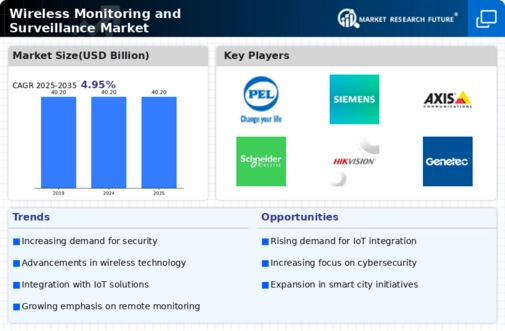Top Industry Leaders in the Wireless Monitoring Surveillance Market
Competitive Landscape of the Wireless Monitoring and Surveillance Market
The global wireless monitoring and surveillance market is surging, fueled by rising security concerns, technological advancements, and growing demand across diverse sectors. Navigating this dynamic landscape requires keen insights into the key players, their strategies, and emerging trends. This analysis delves into the competitive landscape, offering a comprehensive overview of market leaders, their approaches, and factors influencing market share.
Key Players:
- Texas Inc (US)
- Cisco Systems (US)
- Axis Communication (Sweden)
- Sony Enterprises (Japan)
Factors influencing Market Share Analysis:
- Product Portfolio Breadth and Depth: Offering a diverse range of solutions for various applications and sectors (retail, healthcare, residential, etc.) expands market reach and attracts a wider customer base.
- Technological Innovation: Integrating cutting-edge technologies like artificial intelligence, cloud computing, and edge computing into surveillance systems enhances functionality, user experience, and market competitiveness.
- Distribution Network and Channel Partnerships: Secure and efficient distribution channels and strong partnerships with system integrators and security service providers are crucial for reaching customers and ensuring successful installations.
- Brand Reputation and Customer Service: Building trust and providing exceptional customer service foster brand loyalty and attract new customers in a competitive market.
- Pricing Strategy and Cost-Effectiveness: Balancing competitive pricing with product quality and feature sets is essential for attracting budget-conscious buyers and expanding market share.
New and Emerging Companies:
- Cloud-Based SaaS Providers: Companies like Verkada and OpenEye offer cloud-based video surveillance solutions, disrupting the traditional hardware-centric market with subscription-based services and remote management capabilities.
- Cybersecurity-Focused Players: With data privacy concerns rising, companies like CyberLynk and Galtronics specialize in secure wireless surveillance systems designed to protect sensitive information and mitigate cyberattacks.
- IoT Integration Startups: Startups like Wyze and Ring are merging wireless monitoring with the Internet of Things (IoT), creating user-friendly smart home security systems with interconnectivity and automation features.
Current Company Investment Trends:
- Focus on Artificial Intelligence (AI): Companies are heavily investing in AI-powered video analytics for object detection, anomaly recognition, and predictive maintenance, adding intelligence and value to surveillance systems.
- Cloud-Based Solutions: The shift towards cloud-based video storage and management platforms is gaining traction, offering scalability, accessibility, and cost-efficiency to diverse users.
- Cybersecurity Enhancements: With increased reliance on wireless technologies, companies are prioritizing data encryption, secure communication protocols, and vulnerability management to address cybersecurity threats.
- Vertical Market Specialization: Players are tailoring their offerings to cater to specific needs of verticals like healthcare, transportation, and logistics, addressing unique challenges and compliance requirements.
Latest Company Updates:
Jan 18, 2024: Hikvision, a leading surveillance technology provider, unveiled its new line of AI-powered thermal cameras designed for enhanced perimeter security. These cameras utilize advanced algorithms to detect intruders even in low-light or challenging weather conditions, offering robust protection for critical infrastructure and sensitive areas.
Jan 20, 2024: Axis Communications, a renowned network camera manufacturer, has partnered with Verkada, a cloud-based video surveillance provider. This collaboration provides a hybrid solution, combining Axis' high-quality cameras with Verkada's cloud platform, offering businesses an efficient and scalable video management system.
Jan 17, 2024: Ring, a popular smart home security brand, announced its integration with Philips Hue smart lighting systems. This integration allows users to control their lights seamlessly through the Ring app, further enhancing security and automation capabilities within the smart home environment.
Jan 19, 2024: The European Union is proposing new regulations aimed at restricting the use of facial recognition technology in public spaces. These regulations aim to address privacy concerns and prevent potential misuse of the technology. The proposal sparked debate and is expected to face further discussions and amendments.
Jan 22, 2024: Cybersecurity researchers highlighted the growing risk of cyberattacks targeting IoT-based surveillance systems. They urged manufacturers and users to prioritize security measures like regular updates, strong password protocols, and network segmentation to mitigate vulnerabilities.









